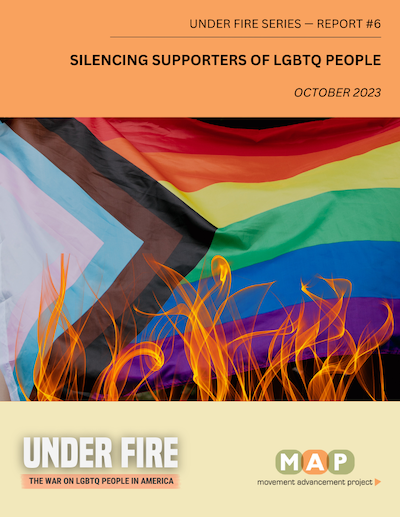In "Under Fire," a new series of reports, MAP connects the dots on the varied ways that LGBTQ people are under siege from a targeted and coordinated campaign to undermine equality and ultimately erase LGBTQ people from public life.
Click below to read and download each report in the series.
"Under Fire: The War on LGBTQ People in America" — Report #1, PDFDownload "Erasing LGBTQ People from Schools and Public Life" — Report #2, PDFDownload "Erecting Systemic and Structural Barriers to Make Change Harder" — Report #3, PDFDownload the report "Enshrining Inequality for LGBTQ People" — Report #4, PDFDownload "Banning Medical Care and Legal Recognition for Transgender People" — Report #5, PDFDownload the Report "Silencing Supporters of LGBTQ People" — Report #6, PDFDownload Related — "Freedom Under Fire: The Far Right's Battle to Control America"Read the Report
It could be easy to think that LGBTQ people are continuing to move toward acceptance and equality, but in fact, the opposite is true. LGBTQ people in America are under attack like never before. Certainly, there has been increased media attention to so-called “Don’t Say Gay or Trans” bills and efforts to
censor school curricula, ban books,
ban transgender youth from playing sports, and
ban transition-related care for transgender youth. Seeing each of these issues individually is like focusing on a single skirmish without understanding that they are part of a larger war against LGBTQ people in America.
Anti-LGBTQ forces want nothing less than to eliminate openly LGBTQ people from the fabric of society. They are launching fast, furious, and coordinated attacks that are astonishing in their breadth, cruelty, and flagrant disregard for personal freedoms. In this new series, MAP will dive deeper into each of these attacks, how opponents are executing these attacks, and how these attacks are impacting LGBTQ people.
There are several different ways in which anti-LGBTQ activists are attacking LGBTQ people and their right to exist. The goal of these activists is to eliminate LGBTQ people from society by:
- Erasing LGBTQ people from schools and public life.
They want to make it impossible for LGBTQ youth to be themselves in schools—banning or fining teachers and schools for even talking about LGBTQ people or issues, pulling books off library shelves, and banning teachers from supporting LGBTQ students. In short, they want LGBTQ youth to be treated like they don’t exist, and those who disagree will be fired, fined, or even imprisoned.
>> For more, read our second report linked here.
- Erecting systemic and structural barriers to make change harder.
By rolling back voting rights, doubling down on gerrymandering, insulating lawmakers from accountability, and much more, these opponents have made it even harder than ever before for individuals to make change, or to elect leaders that reflect the values held by the majority of Americans, including support for LGBTQ people.
>> For more, read our third report linked here.
- Enshrining inequality.
They want to enshrine legal inequality so that LGBTQ people and their families will be poorer, less secure, and face more obstacles. This includes repealing or fighting nondiscrimination protections so that LGBTQ can be fired or not hired, refused housing, denied service in public places, even denied medical care, and more.
>> For more, read our fourth report linked here.
- Criminalizing and banning transition so transgender people can’t be themselves.
Opponents want to make it impossible for transgender people to be themselves by banning transition-related care and criminalizing supportive parents and doctors. They are also prohibiting transgender and nonbinary people from updating their identity documents like birth certificates driver's licenses, and ID cards. They are passing policies requiring governments, schools, and teachers to only recognize sex assigned at birth or inaccurate pronouns.
>> For more, read our fifth report linked here.
- Silencing supporters.
Anti-LGBTQ opponents also want to silence, sue, fine and penalize parents, teachers, doctors, companies and others who are LGBTQ allies.
>> For more, read our sixth report linked here.
In all these efforts, opponents are using increasingly dangerous and inflammatory rhetoric to vilify LGBTQ people. Anti-LGBTQ activists paint LGBTQ people as predators and foment violence against them. The resurgence of the “groomer” narrative—that LGBTQ people are explicitly sexualizing and abusing children—is particularly troubling and dangerous. These harmful narratives seek to push LGBTQ people to the corners of society and have them fear for their lives.
Recommended citations format:
Movement Advancement Project. February 2023.
Under Fire: The War on LGBTQ People in America.
https://www.mapresearch.org/under-fire-report.
Movement Advancement Project. March 2023.
Under Fire: Erasing LGBTQ People from Schools and Public Life.
https://www.mapresearch.org/under-fire-report.
Movement Advancement Project. June 2023.
Under Fire: Erecting Systemic and Structural Barriers to Make Change Harder.
https://www.mapresearch.org/under-fire-report.
Movement Advancement Project. August 2023.
Under Fire: Enshrining Inequality for LGBTQ People.
https://www.mapresearch.org/under-fire-report.
Movement Advancement Project. September 2023.
Under Fire: Banning Medical Care and Legal Recognition for Transgender People.
https://www.mapresearch.org/under-fire-report.
Movement Advancement Project. October 2023.
Under Fire: Silencing Supporters of LGBTQ People.
https://www.mapresearch.org/under-fire-report.


